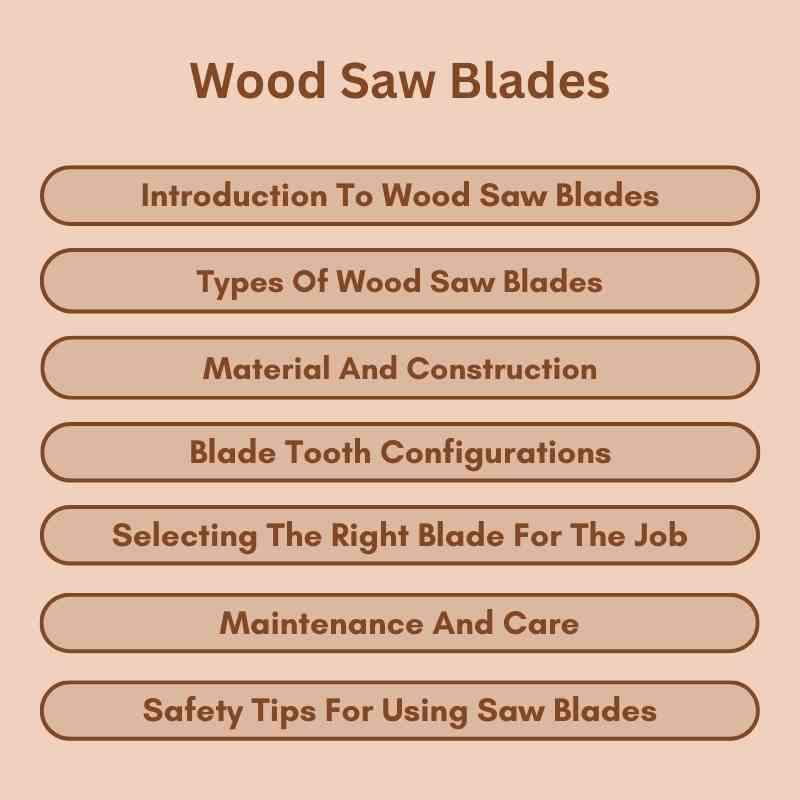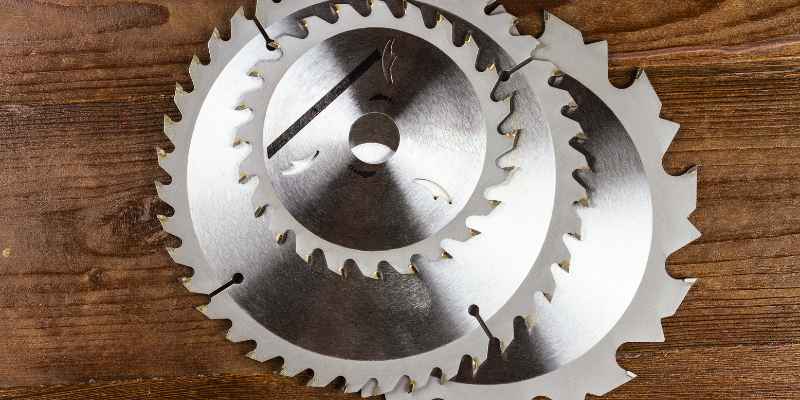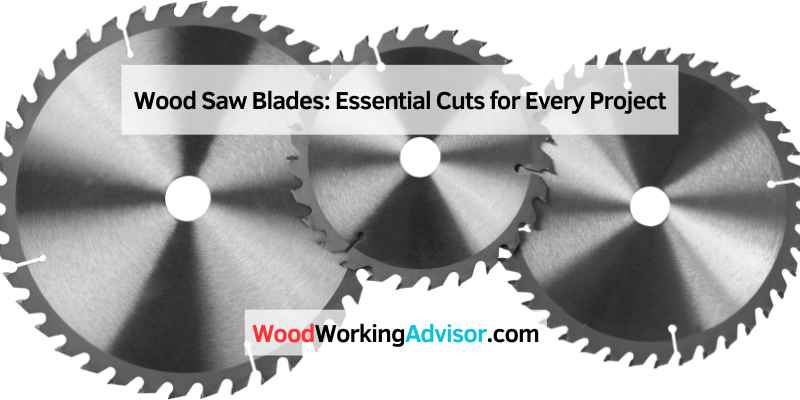Wood saw blades are essential tools for cutting wood efficiently. They come in various types, each designed for specific applications.
Choosing the right wood saw blade can significantly enhance your woodworking experience. Different materials and designs cater to various tasks, from smooth finishes to rough cuts. A high-quality blade ensures cleaner cuts, minimizes splintering, and improves overall safety. Understanding the differences between ripping blades, crosscut blades, and combination blades can help you make informed choices.
Proper maintenance, including regular sharpening, extends the lifespan of your saw blades, ensuring optimal performance. Whether you’re a hobbyist or a professional, investing in the right wood saw blade is crucial for achieving precision in your projects. Explore your options and elevate your woodworking skills today.
Introduction To Wood Saw Blades
Wood saw blades are essential tools in woodworking. They come in various types for different tasks. Understanding these blades helps in making precise cuts.
The Role In Woodworking
Wood saw blades play a crucial role in every woodworking project. They determine the quality of cuts and the finish of the wood. Here are some key points about their role:
- They create smooth edges.
- They allow for different cut styles.
- They enhance the efficiency of the work.
Variety Of Blades For Different Cuts
Different tasks require different types of saw blades. Choosing the right blade impacts the outcome of your project. Below are common types of wood saw blades:
| Blade Type | Best For | Teeth Count |
|---|---|---|
| Rip Blade | Long cuts along the grain | 24-30 teeth |
| Crosscut Blade | Cutting across the grain | 60-80 teeth |
| Combination Blade | Versatile cuts | 40-50 teeth |
| Finishing Blade | Smooth finishes | 80+ teeth |
Each blade has its unique design and purpose. Selecting the right blade enhances performance.

Types Of Wood Saw Blades
Choosing the right wood saw blade is crucial for effective cutting. Each type of blade serves a specific purpose. Understanding these types can improve your woodworking projects significantly.
Rip Cut Blades
Rip cut blades are designed for cutting along the grain of the wood. They have fewer teeth, which allows for faster cuts. This design also reduces friction and helps in chip removal.
- Teeth count: Usually between 24 to 30 teeth.
- Ideal for: Lumber, plywood, and large boards.
- Cutting style: Rough cuts.
Crosscut Blades
Crosscut blades are perfect for cutting across the grain. They feature more teeth, which creates smoother edges. This type of blade minimizes splintering.
- Teeth count: Typically 40 to 80 teeth.
- Ideal for: Furniture, trim work, and cabinetry.
- Cutting style: Fine cuts.
Combination Blades
Combination blades offer versatility. They can perform both rip and crosscuts effectively. This type of blade balances tooth design for various tasks.
- Teeth count: Usually around 40 to 50 teeth.
- Ideal for: General-purpose cutting.
- Cutting style: Good for both rough and fine cuts.
| Blade Type | Teeth Count | Best For | Cutting Style |
|---|---|---|---|
| Rip Cut Blade | 24-30 | Lumber, Plywood | Rough Cuts |
| Crosscut Blade | 40-80 | Furniture, Trim Work | Fine Cuts |
| Combination Blade | 40-50 | General-Purpose | Rough & Fine Cuts |
Material And Construction
The material and construction of wood saw blades greatly affect their performance.
Different materials provide unique benefits.
Understanding these differences helps in making the right choice.
Steel Blades
Steel blades are popular for their durability and affordability.
They are made from high-carbon steel.
This material offers good flexibility and strength.
- Pros:
- Cost-effective
- Easy to sharpen
- Suitable for softwoods
- Cons:
- Wear out faster on hardwoods
- Less resistant to heat
Carbide-tipped Blades
Carbide-tipped blades are made with a steel core and carbide tips.
They are ideal for cutting hardwoods and engineered wood.
The carbide tips resist wear and heat better than steel.
| Feature | Carbide-Tipped Blades |
|---|---|
| Longevity | Long-lasting |
| Sharpness | Remains sharp longer |
| Cost | Higher initial investment |
Blade Coatings
Blade coatings enhance performance and durability.
Common coatings include Teflon and titanium.
These coatings reduce friction and prevent rust.
- Benefits of Coatings:
- Improved cutting efficiency
- Reduced heat buildup
- Extended blade life
Blade Tooth Configurations
Understanding blade tooth configurations is crucial for effective cutting. The type of teeth affects the saw’s performance, speed, and finish. Let’s explore the key aspects of blade tooth configurations.
Tooth Shape And Angle
The tooth shape significantly influences how a blade cuts through wood. Common shapes include:
- Flat Top: Ideal for cross-cutting.
- Alternate Top Bevel: Best for ripping and cross-cutting.
- Negative Rake: Great for smoother cuts.
The angle of the teeth also matters. A steeper angle allows faster cutting, while a shallower angle provides a smoother finish.
Gullet Depth
The gullet is the space between teeth. It plays a vital role in chip removal. Here’s why gullet depth matters:
| Gullet Depth | Effect |
|---|---|
| Shallow | Better for clean cuts. |
| Deep | Improves chip removal. |
A deeper gullet helps prevent clogging during heavy cuts. Choose the right depth based on your project needs.
Hook Angle
The hook angle is the tilt of the tooth. This angle affects how aggressively a blade cuts. Common hook angles include:
- Positive Hook: Faster cutting, ideal for softwoods.
- Neutral Hook: Versatile for various materials.
- Negative Hook: Smoother cuts, best for hardwoods.
Understanding hook angles helps you select the right blade for your project.
Selecting The Right Blade For The Job
Choosing the right wood saw blade is crucial for your project. The blade type affects efficiency and quality. Understanding the factors involved helps achieve the best results.
Wood Type And Thickness
Different types of wood require specific blades. The thickness of the wood also plays a role. Here’s a quick guide:
| Wood Type | Recommended Blade |
|---|---|
| Softwood | Fine-toothed blades |
| Hardwood | Coarse-toothed blades |
| Plywood | Thin kerf blades |
For thicker wood, choose a blade with fewer teeth. This will cut faster. For thinner wood, use more teeth for a smooth finish.
Desired Finish Quality
The quality of the finish depends on the blade type. Different finishes require different approaches:
- Rough Cuts: Use a coarse blade.
- Smooth Cuts: Opt for a fine-toothed blade.
- Specialty Cuts: Consider a combination blade.
Choose blades designed for specific finishes. This ensures a polished look on your project.
Saw Compatibility
Ensure the blade fits your saw type. Compatibility affects performance significantly. Here are the common saw types:
- Table Saw
- Circular Saw
- Miter Saw
Check the manufacturer’s specifications. This guarantees optimal performance and safety.
Maintenance And Care
Proper maintenance and care for wood saw blades is essential. It ensures they perform well and last longer. Regular cleaning, sharpening, and safe storage can greatly enhance their lifespan.
Cleaning Techniques
Keeping your saw blades clean is crucial. Dust and resin buildup can affect performance. Here are some effective cleaning methods:
- Use a soft brush to remove debris.
- Soak the blade in warm, soapy water.
- Use a specialized blade cleaner for tough resin.
- Rinse with clean water and dry immediately.
Always wear gloves to protect your hands while cleaning. Regular cleaning after each use helps maintain sharpness.
Sharpening Tips
Sharp blades cut wood smoothly. Dull blades can cause splintering and are unsafe. Follow these tips for sharpening:
- Use a sharpening stone or file.
- Maintain the original bevel angle.
- Check for uneven wear on teeth.
- Sharpen only when necessary.
Consider professional sharpening services for best results. This option can save time and ensure precision.
Storage Solutions
Proper storage protects your blades from damage. Follow these tips to store your saw blades safely:
| Storage Method | Description |
|---|---|
| Blade Cases | Use padded cases to prevent scratches. |
| Magnetic Strips | Mount blades on strips for easy access. |
| Hanging Hooks | Store blades vertically to save space. |
Always label your storage solutions. This practice helps you find the right blade quickly.
Safety Tips For Using Saw Blades
Using saw blades can be dangerous without proper safety measures. Follow these tips to ensure your safety and the safety of others.
Proper Handling
Safe handling of saw blades is crucial. Here are key points to remember:
- Always hold the saw with both hands.
- Keep your fingers away from the blade path.
- Use the right blade for the material.
- Inspect blades for damage before use.
- Store blades properly when not in use.
Protective Gear
Wearing protective gear reduces the risk of injury. Essential gear includes:
| Gear | Purpose |
|---|---|
| Safety Glasses | Protect eyes from flying debris. |
| Hearing Protection | Prevent hearing damage from loud noise. |
| Gloves | Protect hands from sharp edges. |
| Dust Mask | Filter out harmful dust particles. |
Avoiding Kickback
Kickback can cause serious injuries. To avoid it:
- Keep the blade sharp and clean.
- Secure the workpiece firmly.
- Use a blade guard when possible.
- Do not force the saw through the material.
- Stand to the side of the saw, not behind it.
Following these safety tips helps prevent accidents. Always prioritize safety while using saw blades.
Advanced Techniques
Mastering advanced techniques with wood saw blades enhances your woodworking skills. These methods help achieve precise cuts and improve project quality. Explore stacked dado sets, specialty blades, and troubleshooting tips below.
Stacked Dado Sets
Stacked dado sets create wide grooves in wood. They consist of multiple blades stacked together.
Benefits of using stacked dado sets include:
- Versatility: Cut various widths easily.
- Precision: Achieve clean, flat-bottomed grooves.
- Efficiency: Complete tasks faster than using standard blades.
To use stacked dado sets:
- Adjust the saw’s height for desired groove depth.
- Set the blade width by adding or removing blades.
- Make test cuts on scrap wood.
Specialty Blades For Unique Projects
Specialty blades cater to specific tasks. They enhance the quality of unique projects.
| Blade Type | Best For |
|---|---|
| Crosscut Blade | Making smooth crosscuts in hardwood. |
| Rip Blade | Cutting along the wood grain. |
| Kerf Blade | Thin cuts with minimal waste. |
| Aluminum Blade | Cutting non-ferrous metals. |
Troubleshooting Common Issues
Wood saw blades may face issues during use. Recognizing these problems helps maintain performance.
- Burn Marks: Check for dull blades or slow feed rates.
- Chipped Edges: Ensure proper blade alignment and tightness.
- Uneven Cuts: Verify that the blade is sharp and clean.
Regular maintenance prevents these problems. Keep blades clean and sharp for optimal results.

Frequently Asked Questions
What Are Wood Saw Blades Used For?
Wood saw blades are essential tools for cutting wood. They are designed to slice through various types of lumber. Different blades serve specific purposes, such as ripping or cross-cutting. Choosing the right blade improves efficiency and reduces splintering. Each blade type ensures clean and precise cuts.
How Do I Choose The Right Wood Saw Blade?
Selecting the right wood saw blade depends on your project. Consider the type of wood and the cut required. Blade tooth count affects the finish; more teeth provide smoother cuts. Additionally, choose the appropriate blade size for your saw. Always match the blade type to your cutting needs.
How Often Should I Replace My Saw Blade?
You should replace your saw blade when it shows signs of dullness. A dull blade can cause splintering and reduce accuracy. Generally, inspect the blade after every few uses. If you notice a decline in performance, it’s time for a replacement.
Regular maintenance extends the life of your blade.
Can I Sharpen A Wood Saw Blade?
Yes, you can sharpen a wood saw blade to extend its life. Many professionals recommend periodic sharpening to maintain cutting efficiency. You can use a sharpening service or do it yourself with the right tools. Ensure you understand the sharpening technique for the specific blade type.
Conclusion
Choosing the right wood saw blades can significantly impact your woodworking projects. Quality blades ensure cleaner cuts and longer-lasting performance. Always consider the type of wood and the desired finish. Investing in the right tools will enhance your craftsmanship and lead to impressive results.
Happy woodworking!

